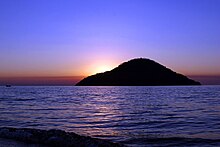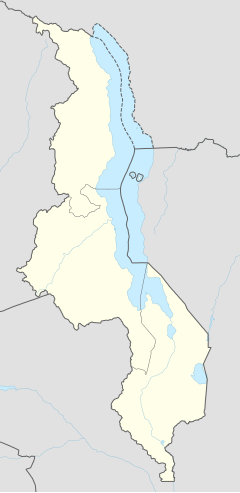Cape Maclear
Cape Maclear Chembe | |
|---|---|
 Otter Point, Cape Maclear | |
| Nickname: The Cape[1] | |
| Coordinates: 14°01′S 34°51′E / 14.017°S 34.850°E | |
| Country | Malawi |
| Region | Southern Region |
| District | Mangochi District |
| Time zone | +2 |
| Climate | Aw |
Cape Maclear or Chembe is a town in the Mangochi District of Malawi's Southern Region. The town, on the Nankumba Peninsula, is on the southern shore of Lake Malawi and is the busiest resort on Lake Malawi.[2] Cape Maclear is close to the islands of Domwe, Thumbwe and Mumbo Island on Lake Malawi,[3] and is in Lake Malawi National Park.
History
In 1859, the missionary and explorer David Livingstone uncovered the Cape, and named it "Cape Maclear" after his friend, the astronomer Thomas Maclear, who was Her Majesty's Astronomer at the Cape of Good Hope.[4][5] In October 1875, a new mission, "Livingstonia", was set up by a group of members of the Free Church of Scotland.[6][7] Before the missionaries arrived, the area was controlled by the Muslim Yao people.[8] The graves of some of the missionaries are in Cape Maclear, overlooking the bay.[9] Although Cape Maclear had a good harbour, the poor soil in the area, and the prevalence of the tsetse fly, meant a more suitable base had to be found;[10] the mission moved to Bandawe, near Chintheche, in 1882.[11]
Wildlife

Cape Maclear and its islands, forests and bay were declared a national park in 1980, creating the Lake Malawi National Park, the first freshwater national park in the world.[12] In 1984, the area became a UNESCO World Heritage Site.[13] There are several species of bird at Cape Maclear, including kingfishers, Dickinson's kestrels, and freckled nightjars.[14] There is a museum about the formation of Lake Malawi and its wildlife at Cape Maclear.[3] UNESCO has recommended wildlife preservation at Cape Maclear.[15]
Tourism

Cape Maclear is "a leading tourist destination",[15] and is the busiest resort on Lake Malawi.[2] The area is popular with backpackers.[16] There are bars, restaurants, lodges and guesthouses in the town.[17] Activities available in Cape Maclear include snorkelling, hiking, boat cruises, kayaking, and diving. In October 2001, the Malawian government invited investors to fund a $6,000,000 construction of a new 150-room, four-star hotel at Cape Maclear.[18] In June 2003, plans were announced to build an ecolodge on Maleri Island, near Cape Maclear.[19] In February 2005, the Malawian government announced plans to increase ecotourism at Cape Maclear with new accommodation and facilities.[20] These plans proved too ambitious for the fragile Malawian economy and tourist industry.
Transport
In February 2006, the Malawian government announced plans to build a new road from Cape Maclear to Monkey Bay.[21] The current road is a bumpy dirt track,[22] and there is no regular public transport at Cape Maclear.[23] Regular bus service extends only from Lilongwe to Monkey Bay where private minibuses can be hired for the trip to Cape Maclear.
Healthcare
There is a medical clinic in Cape Maclear; the Billy Riordan Memorial Clinic was established in 2004, and treats diseases such as dysentery, bilharzia and malaria. There are no diagnostic services or surgery carried out at the clinic. Mags Riordan, who founded the clinic, is the mother of a man who drowned in Lake Malawi, near Cape Maclear in 1999. The clinic is supported by the Billy Malawi Project.[1][24]
Bilharzia is common at Cape Maclear; the incidence of the disease at Cape Maclear is three times higher than the rest of Lake Malawi.[25]
Sport
Every summer, a multi-day yacht race is held on Lake Malawi. The race starts at Cape Maclear, heads north, and ends at Nkhata Bay.[26]
References
- ^ a b Collins, Dr. Martina (10 June 2008). "Life as a GP in Malawi —the warm heart of Africa". Irish Medical Times. Archived from the original on 2 June 2009. Retrieved 24 June 2008.
- ^ a b Rogers, Douglas (5 February 2001). "Malawi: On a mission in Africa (2)". The Daily Telegraph. Retrieved 24 June 2008.[dead link]
- ^ a b Murphy, Alan; Armstrong, Kate; Firestone, Matthew D.; Fitzpatrick, Mary (2007). Lonely Planet Southern Africa: Join the Safari. Lonely Planet. p. 201. ISBN 978-1-74059-745-6. Retrieved 24 June 2008.
- ^ Bass, Thomas A. (1990). Camping with the Prince and Other Tales of Science in Africa: And Other. Houghton Mifflin. p. 94. ISBN 0-395-41502-0. Retrieved 24 June 2008.
- ^ Livingstone, David (1865). Narrative of an Expedition to the Zambesi and Its Tributaries: And of the. J. Murray. p. 368. Retrieved 24 June 2008.
- ^ Murphy, Alan; Armstrong, Kate; Firestone, Matthew D.; Fitzpatrick, Mary (2007). Lonely Planet Southern Africa: Join the Safari. Lonely Planet. p. 160. ISBN 978-1-74059-745-6. Retrieved 24 June 2008.
- ^ Good, Charles M. (2000). The Steamer Parish: The Rise and Fall of Missionary Medicine on an African. University of Chicago Press. p. 61. ISBN 0-226-30281-4. Retrieved 24 June 2008.
- ^ Good, Charles M. (2000). The Steamer Parish: The Rise and Fall of Missionary Medicine on an African. University of Chicago Press. p. 62. ISBN 0-226-30281-4. Retrieved 24 June 2008.
- ^ Murphy, Alan; Armstrong, Kate; Firestone, Matthew D.; Fitzpatrick, Mary (2007). Lonely Planet Southern Africa: Join the Safari. Lonely Planet. p. 202. ISBN 978-1-74059-745-6. Retrieved 24 June 2008.
- ^ The American missionary. Cornell University. 1 February 1879. Retrieved 24 June 2008.
- ^ "The American missionary". Cornell University. 1 July 1882. Retrieved 24 June 2008.
- ^ Fischer, Andreas (30 June 2007). "Das "warme Herz Afrikas" liegt im Süden (1)". Hamburger Abendblatt. Retrieved 24 June 2008.
- ^ Bass, Thomas A. (1990). Camping with the Prince and Other Tales of Science in Africa: And Other. Houghton Mifflin. p. 93. ISBN 0-395-41502-0. Retrieved 24 June 2008.
- ^ Riley, Laura; Riley, William (2005). Nature's Strongholds: The World's Great Wildlife Reserves. Princeton University Press. p. 100. ISBN 0-691-12219-9. Retrieved 24 June 2008.
- ^ a b Chimwala, Marcel (20 May 2005). "Malawi scouts investors for tourism initiative..." Engineering News. Retrieved 24 June 2008.
- ^ Walters, Joanna (8 June 2003). "Take the plunge in the lake of stars". The Observer. Retrieved 24 June 2008.
- ^ Rogers, Douglas (5 February 2001). "Malawi: On a mission in Africa (1)". The Daily Telegraph. Archived from the original on 5 September 2008. Retrieved 24 June 2008.
- ^ Chimwala, Marcel (19 October 2001). "Malawi seeks investor for hotel project". Engineering News. Retrieved 24 June 2008.
- ^ Chimwala, Marcel (13 June 2003). "Malawi plans development of eco-lodges". Engineering News. Retrieved 24 June 2008.
- ^ Chimwala, Marcel (18 February 2005). "Tenders invited for Lake Malawi ecotourism project". Engineering News. Retrieved 24 June 2008.
- ^ "Malawi: Investors, Tourists Wear Smile in Cape Maclear". AllAfrica. 28 February 2006. Retrieved 24 June 2008.
- ^ Murphy, Alan; Armstrong, Kate; Firestone, Matthew D.; Fitzpatrick, Mary (2007). Lonely Planet Southern Africa: Join the Safari. Lonely Planet. p. 204. ISBN 978-1-74059-745-6. Retrieved 24 June 2008.
- ^ "Animal magic". The Guardian. 6 April 2001. Retrieved 24 June 2008.
- ^ "GPs needed for Malawi project". Irish Medical Times. 28 May 2008. Retrieved 31 March 2017.
- ^ Dawood, Richard M. (2002). Travellers' Health: How to Stay Healthy Abroad. Oxford University Press. p. 108. ISBN 0-19-262947-6. Retrieved 24 June 2008.
- ^ Fischer, Andreas (30 June 2007). "Das "warme Herz Afrikas" liegt im Süden (2)". Hamburger Abendblatt (in German). Retrieved 24 June 2008.
External links
 Cape Maclear travel guide from Wikivoyage
Cape Maclear travel guide from Wikivoyage

